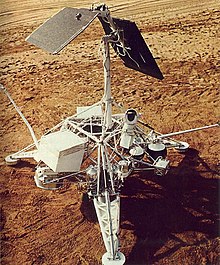Surveyor
Surveyor (English for land surveyor ) is the name of a series of American space probes from NASA that landed on the moon between 1966 and 1968 .
mission
The Surveyor program was launched as the successor to the Ranger moon probes. The aim was to practice soft landings on the moon's surface, a very important aspect when preparing for the manned moon landing . Likewise, the possibility of making course corrections was proven, and the surface of the moon etc. a. examined with shovels in order to determine the thickness of the suspected dust layer. The landing sites were selected according to possible Apollo landing sites, but also according to geological aspects. In order to be able to measure the impact forces on landing, strain gauges were used without knowing beforehand how the vacuum would affect the measurement result. The program cost 580 million US dollars, which at the time was equivalent to 2.32 billion DM .
The Surveyor probes were built by the Hughes Aircraft Company and launched using Atlas Centaur rockets from Launch Complex 36 on Cape Canaveral . They each weighed around 1,000 kg and were equipped with high-performance cameras as well as numerous detectors and instruments.
course
- Between December 1964 and October 1966 a total of five test flights with dummy probes took place. These flights were used to test the Atlas Centaur launcher and the flight profile for launching it into a transfer orbit to the moon.
- Surveyor 1 took off on May 30, 1966 and landed three days later in Oceanus Procellarum . The probe worked on the lunar surface for around six weeks until July 14, 1966 and transmitted 11,200 images. Surveyor 1 marked the first soft landing by a US probe on the moon. However, the USSR had beaten the Americans and had already made a soft landing with Luna 9 on February 3, 1966.
- Surveyor 2 took off on September 20, 1966, but could not land softly two days later, but hit hard at Gambart C crater near Copernicus and was destroyed in the process.
-
Surveyor 3 launched on April 17, 1967. Three days later, the probe landed successfully in Oceanus Procellarum and remained active until May 4, 1967. She transmitted 6,300 images and carried out a drilling experiment. During the Apollo 12 moon landing in November 1969, Surveyor 3 was selected as the approach target. Parts of the probe, especially its camera, were dismantled and brought back to Earth by astronauts Charles Conrad and Alan Bean . During the subsequent examination of the parts, the microbiologist Frederick Mitchell was able to determine that there were dried bacteria ( Streptococcus mitis ) in the insulation of the camera . There were suspicions that they were left there by a fitter of the probe who had a cold. The bacteria were able to germinate again in the incubator and were considered an indication of possible survivability in space (see panspermia ). However, more recent investigations of historical documents in 2011 cast doubts on this assessment because the standards for the clean room used were not sufficient to rule out self-contamination. The camera is now in the National Air and Space Museum .
 Surveyor 3 spacecraft under investigation by astronauts on the Apollo 12 mission
Surveyor 3 spacecraft under investigation by astronauts on the Apollo 12 mission - Surveyor 4 took off on July 14, 1967, but again failed to land. The probe hit the medial sinus hard three days later .
- Surveyor 5 started on September 8, 1967, landed three days later in the Mare Tranquillitatis ("Sea of Peace") and sent 19,000 images, data and analyzed a soil sample by December 17, 1967.
- Surveyor 6 started on November 7, 1967, landed three days later in the Sinus Medii and worked until December 14, 1967. The probe transmitted 15,000 images and numerous data. On November 17, 1967, the probe's engine was restarted and the probe touched down again 2.5 m away.
- Surveyor 7 took off on January 7, 1968 and landed near Tycho Crater three days later . The probe had sent 21,000 images by February 21, 1968.
Result
The Surveyor program ended with five successful moon landings (success rate: 71%). The probes analyzed the lunar soil, photographed the surface and thus successfully prepared the ground for the manned moon landing, in particular by proving that astronauts would not sink into the dust on the moon. In March 2010, the Lunar Reconnaissance Orbiter u. a. Recordings from Surveyor 5.
See also
Web links
- Bernd Leitenberger: The Surveyor space probes
- Surveyor (1966–1968) (English)
- Results of the Surveyor Program (PDF; 31.3 MB) 1969 (English)
- Analysis of Surveyor 3 material and photographs returned by Apollo 12 (PDF; 24.9 MB) 1972 (English)
- Exploring the Moon: The Surveyor Program (English)
swell
- ^ Leonard David: Moon Microbe Mystery Finally Solved. Space.com, May 2, 2011, accessed March 13, 2016 .
- ↑ Surveyor 5 nasa.gov, Lunar Reconnaissance Orbiter, March 22, 2010 (access = March 29, 2010)
